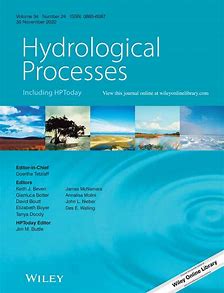- Topic:Water and matter cycles
Moving Bedforms Control CO2 Production and Distribution in Sandy River Sediments
The study investigated the impact of streamwater flow velocities and the resulting bedform migration on the CO2 production in streambeds. State-of-the-art 2-dimensional imaging techniques reveal the CO2 distribution in the streambed, an increasing CO2 production in the upper sediment and a decreasing hydrological exchange with deeper sediment layers, with increasing flow velocities.
The unexpected long period of elevated CH4 emissions from an inundated fen meadow ended only with the occurrence of cattail (Typha latifolia)
The authors present 14 years of CH4 flux measurements following rewetting of a formerly long-term drained peatland. During the study, significant differences in CH4 emissions occurred. These differences overlapped with stages of ecosystem transition from a cultivated grassland to a polytrophic lake dominated by emergent helophytes, but could also be additionally explained by other variables.
Anaerobic duration predicts biogeochemical consequences of oxygen depletion in lakes
A team from TU Bergakademie Freiberg and IGB has developed an easy-to-use method to estimate the consequences of oxygen depletion in the deep water of lakes. Monitoring data from L. Arendsee and L. Stechlin, a.o., were used to model the spatiotemporal extent of anoxia. The novel tool has the potential to predict the ecological consequences of increasing anoxia in lakes due to climate warming.
Enhancing urban runoff modelling using water stable isotopes and ages in complex catchments
Hydrological and water stable isotope datasets within a modelling framework were utilized to evaluate the water flow paths and ages in the heavily urbanized Panke catchment in Berlin. Groundwater was the primary flow component in reaches with less urbanisation. Wastewater effluent dominated the mid-reaches with direct storm runoff and shallow subsurface contributions in the urbanized reaches.
Integrating urban water fluxes and moving beyond impervious surface cover: a review
This review paper by international female experts on urban hydrology identifies gaps in our understanding of how water flows through built landscapes. It focuses on key topics within urban hydrology related to water quantity, incl. runoff and streamflow generation, soils and soil water, groundwater, vegetation, and climate; describes challenges and opportunities in the field of urban hydrology.
Using stable water isotopes to understand ecohydrological partitioning under contrasting land uses in a drought-sensitive rural, lowland catchment
To analyse the influence of vegetation on water partitioning under land management strategies, the authors used stable water isotopes with contrasting land covers and soil types in the Demnitzer Millcreek. The study underlined the need for long-term observations of land use changes and drought-sensitive vegetation to evolve a drought resilient land management considering time lags.
Dynamics in impervious urban and non-urban areas and their effects on run-off, nutrient emissions, and macroinvertebrate communities
About 20 % of the newly sealed area is not in urban areas, but in rural areas, according to the model calculations of this study. Calculations of nutrient fluxes into water bodies have not taken these new sealings in rural areas into account, because these are often based on land use maps and consider urban areas. As a result, the nutrient loads of water bodies are systematically underestimated.
The role of boundary mixing for diapycnal oxygen fluxes in a stratified marine system
The research team investigated the vertical oxygen flux through the halocline in the Baltic Sea using high-resolution temperature and oxygen profiles during different seasons. Oxygen transport showed a strong seasonality and was higher in autumn compared to summer and winter. The shoreline regions were responsible for >80% of the total oxygen transport through the halocline.
Formation of vivianite in digested sludge and its controlling factors in municipal wastewater treatment
Phosphorus as scare raw material can be recovered from municipal wastewater treatment as iron phosphate mineral vivianite. Vivianite formation increased with higher iron and lower sulphur content. The study suggests that the use of sulphur-free precipitants for chemical P elimination may enhance vivianite formation. The new insights are also of high relevance for the research on aquatic sediments.
Fate of trace organic compounds in the hyporheic zone: influence of microbial metabolism
The authors investigated the influence of microbial processes on the fate of trace organic compounds in stream sediments. The study demonstrates the usefulness of the fluorescent tracer system resazurin-resorufin for determining microbial metabolism and disentangling specific reactive properties and ultimately their influence on the fate of contaminants in natural hyporheic zones.










